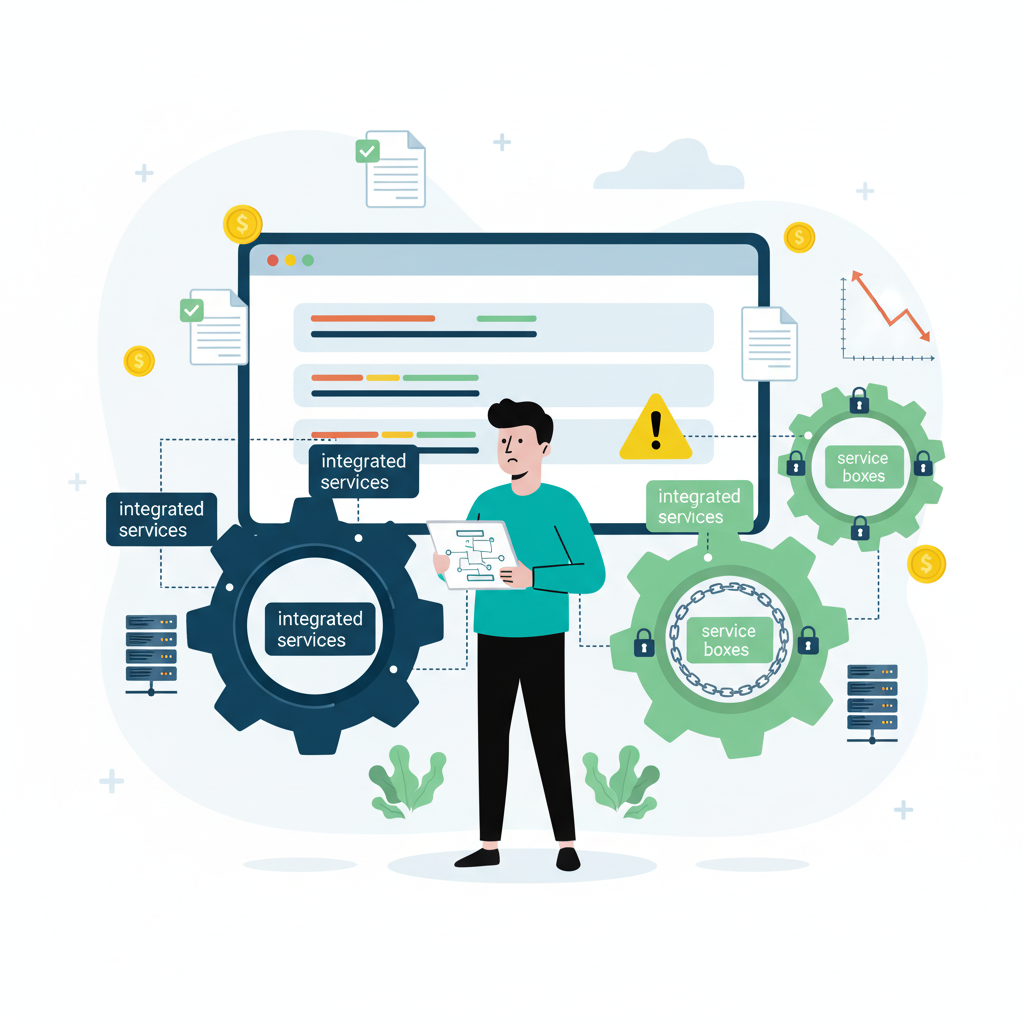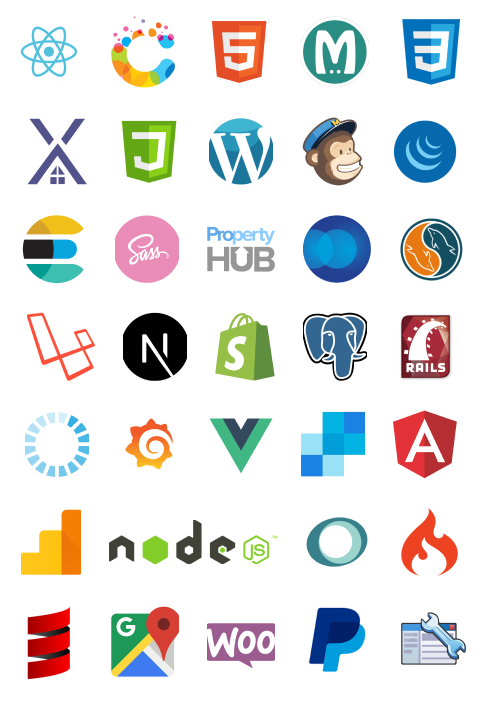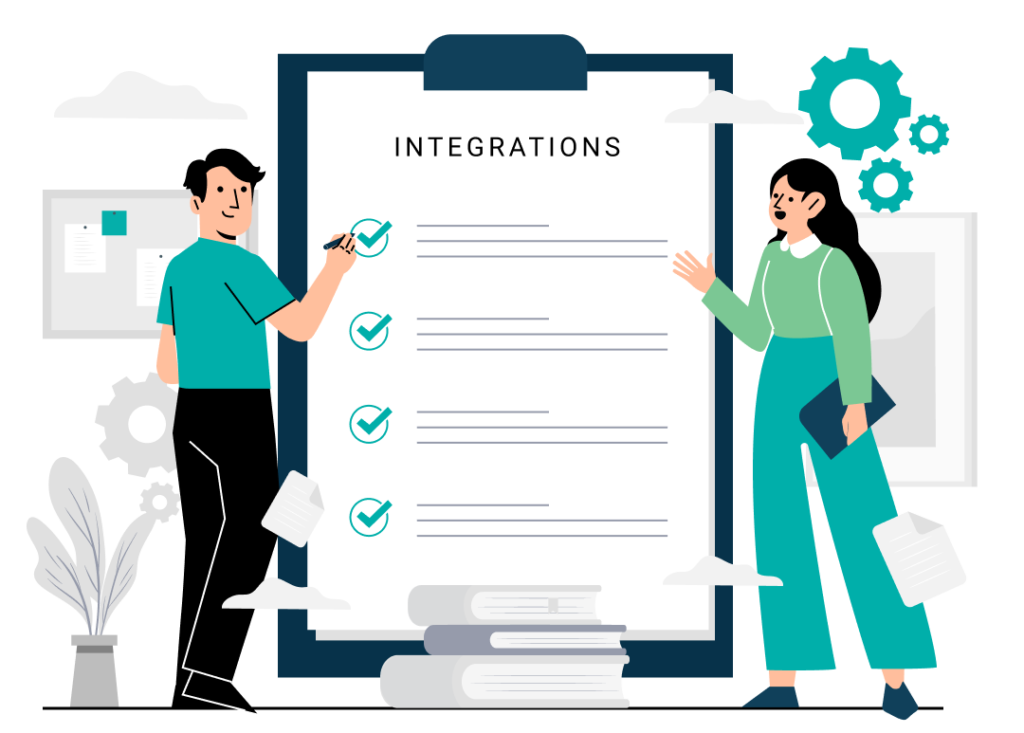Every API integration you implement today makes your business more productive. It also makes leaving that vendor more expensive tomorrow. That’s the paradox you’re living with whether you realise it or not. This analysis is part of our comprehensive guide to network effects and platform strategy, exploring how mathematical forces shape technology markets and vendor relationships.
Vendor lock-in isn’t binary. It’s progressive gravity. Shallow integrations have escape velocity—you can leave if you need to. Deep integrations create gravitational wells where switching costs exceed what you can realistically invest. You’re trapped, and the vendor knows it.
Most organisations don’t have frameworks to quantify lock-in risk before integration decisions compound into million-dollar migration projects. This article gives you a staged integration model showing how switching costs escalate exponentially, explains the difference between data versus feature portability, and provides decision criteria for when abstraction justifies complexity cost.
What are the different levels of integration depth and how do switching costs escalate at each level?
Integration depth exists on a continuum from simple API calls to deep platform dependencies. Think of it as three stages.
Stage 1: Simple API Calls. RESTful APIs for read-only data access or basic CRUD operations. Switching costs run $5K-50K. Migration timeline is weeks to months.
Stage 2: Workflow Automation. Business process orchestration across systems using platform integration features. Switching costs jump to $50K-500K. Migration timeline stretches to months or quarters.
Stage 3: Platform-Specific Features. Deep vendor-unique functionality—Salesforce Apex code, AWS Lambda functions, SAP custom modules. Switching costs hit $1M-50M. Migration timeline is 1-5 years.
Here’s what catches people: Stage 3 costs typically 100-1000x more than Stage 1, not 3x. This is exponential escalation, not linear. This lock-in mechanism directly contributes to why dominant platforms benefit from these switching costs, reinforcing market concentration.
So categorise your existing integrations by stage to understand current risk exposure. That’s how you make informed decisions about future integration depth instead of sleepwalking into vendor dependency.
How does integration complexity create exponentially increasing switching costs?
Switching costs grow exponentially because integrations create dependencies that multiply rather than add.
Simple formula: n integrations create n(n-1)/2 potential interaction points. 10 integrations equal 45 interaction points. 20 integrations equal 190 interaction points. An Oracle ERP instance with 15 integrated systems has 105 interaction points to unwind.
Technical debt accumulates as custom code, workarounds, and vendor-specific workarounds become embedded in business processes over time. These integrations become part of how your business operates—embedded in daily workflows and organisational muscle memory.
Data accumulation multiplies the effect. That Microsoft Dynamics instance you’ve been using for eight years? You’re not just migrating data. You’re migrating eight years of business process evolution.
Then hidden costs emerge during migration: data cleansing, format conversion, feature gap analysis, parallel running, rollback provisions, training, documentation. Here’s a practical number: average enterprise integration requires 20-40 hours annual maintenance. If you have 50 integrations, that’s 1000-2000 hours yearly—$100K-200K in maintenance costs alone.
What is the difference between data portability lock-in and feature portability lock-in?
Data portability lock-in means you can’t extract complete, usable data from a vendor platform in standard formats. Feature portability lock-in means you can extract data, but you can’t replicate platform-specific functionality in alternative systems.
Data portability should be a minimum requirement for any integration commitment. If a vendor won’t guarantee complete data export in usable formats, you’re taking on substantial risk.
Feature portability is an acceptable trade-off when vendor functionality justifies dependency cost. Salesforce provides data export functionality. But custom Apex code, workflow rules, and process builders aren’t portable—that’s feature lock-in. You can accept that if the platform value justifies the cost. This connects to how unused features create switching costs, where comprehensive feature sets increase vendor dependency even when most features go unused.
Proprietary data formats create lock-in even when APIs provide access. You can access data through APIs but still face vendor lock-in if the format makes it unusable in alternative systems. If your vendor uses vendor-specific schemas, relationship models, and metadata, you’re looking at extensive transformation for alternative platforms.
So negotiate data portability contractually before technical integration begins. Get it in writing: complete data export, standard formats (JSON, XML, CSV with documented schemas), metadata preservation, reasonable egress terms.
What causes technical debt to accumulate from API integrations over time?
API integrations create technical debt through custom implementations, vendor-specific workarounds, and assumptions that become outdated. Unlike product features you can retire, integrations become more entrenched as business processes depend on them.
API version changes force maintenance work. Vendors deprecate old endpoints, introduce breaking changes, modify behaviour. Custom transformation logic accumulates to handle data format mismatches, business rule enforcement, and error handling edge cases.
Documentation decays. Integration knowledge exists in code and departed developers’ heads, not in maintained documentation. When someone needs to modify an integration three years later, they’re reverse-engineering it.
Testing burden grows. Each integration change requires regression testing across connected systems to ensure you haven’t broken something.
How do proprietary data formats create vendor lock-in even when APIs are available?
API access without usable format means you can read data but can’t meaningfully import it elsewhere.
Many SaaS providers use proprietary formats optimised for their specific architecture. Direct migration to alternative platforms becomes difficult or impossible without significant transformation effort. Oracle database migrations cost $50K-500K depending on customisation depth.
Format conversion requires translating vendor-specific concepts, not just data structure changes. Vendor-specific terminology, field names, and data structures embed business logic that must be translated.
Data egress fees compound format problems. Cloud vendors charge for data transfer out of their platforms. AWS charges $0.09/GB for outbound transfer. Azure charges $0.087/GB. Exporting 100TB costs $9,000 in egress fees alone before migration work begins.
So negotiate standard format guarantees in vendor contracts before commitment.
What is the “API gravity” metaphor and how does it explain vendor lock-in?
Think of integrations as creating gravitational pull proportional to depth and mass. Escape becomes increasingly difficult as you get deeper.
Shallow integrations have escape velocity. Switching costs are low enough that migration remains feasible. Deep integrations create gravitational wells where switching costs exceed practical investment. You’re effectively trapped.
“Mass” in this metaphor equals the combination of data volume, customisation count, business process entrenchment, and technical debt accumulation. You can cross a point beyond which migration becomes theoretically possible but practically unrealistic.
Unlike physical gravity, API gravity is engineered by vendors who profit from switching cost barriers. They know exactly what they’re doing. This strategic dynamic connects to broader patterns in technology power laws that govern how platform businesses operate.
You can measure your current gravitational state by calculating switching costs versus annual platform spend. If switching costs exceed 5x annual platform spend, you’ve crossed the event horizon. Understanding these long-term consequences of lock-in helps explain why legacy systems persist for decades despite modern alternatives.
Why do abstraction layers sometimes increase complexity instead of reducing lock-in?
Abstraction layers promise portability but introduce maintenance burden, performance overhead, and limited feature access.
Every abstraction layer is software you must build, test, document, and maintain. It creates its own technical debt. Jumping from call to call to figure out what goes wrong requires an exponential factor of extra traces.
There’s the leaky abstraction problem: vendor-specific details inevitably surface, requiring platform-specific code despite the abstraction. Feature limitation hits you hard. Abstraction layers provide lowest-common-denominator functionality, blocking access to powerful platform-specific features.
Performance overhead adds up. An additional abstraction layer adds latency and processing cost to every integration call. 10-30% latency increase compounds when you’re making thousands of calls.
Companies report that managing infrastructure in different clouds slows teams down. Multi-cloud abstraction layers often cost more to operate than accepting single-vendor lock-in and paying migration costs if needed.
Abstraction justifies complexity cost only when: (1) high likelihood of vendor change, (2) commodity functionality being abstracted, (3) multiple vendors already in use.
An alternative approach: use architecture patterns and design-time abstractions that maintain portability through thoughtful design versus runtime translation. Many successful tech companies started with very simple architectures—Airbnb as monolithic Ruby on Rails, Facebook as PHP site with single database. Understanding convenience features and proprietary lock-in helps you navigate these design trade-offs between ease-of-use and portability.
How can you assess whether current integrations create acceptable lock-in risk?
Lock-in risk assessment requires quantifying switching costs relative to business value and vendor relationship quality.
Step 1: Inventory all integrations and categorise by staged model (Stage 1/2/3) to understand depth distribution.
Step 2: Calculate switching costs for each major integration: data migration plus feature reimplementation plus business disruption plus timeline opportunity cost.
Step 3: Compare switching costs to annual platform spend. Less than 1x is low risk. 1-3x is medium risk. 3-5x is high risk. Above 5x means you’ve crossed the event horizon.
Step 4: Evaluate vendor relationship health. Strong partnership with fair pricing justifies higher lock-in than adversarial relationship.
Step 5: Assess business criticality. Mission-critical systems tolerate less lock-in than peripheral tools.
Red flags: no data export guarantees, proprietary formats without conversion tools, vendor unwilling to document APIs, rapid unexpected price increases.
Acceptable lock-in criteria: data portability guaranteed, switching costs less than 3x annual platform spend, vendor relationship healthy, platform value justifies dependency.
What architecture patterns reduce vendor lock-in without sacrificing functionality?
Architecture patterns like hexagonal architecture provide design-time abstractions rather than runtime translation layers—they cost less to operate and maintain while providing similar portability benefits.
The strangler fig pattern enables gradual replacement of vendor dependencies by routing new functionality to alternative implementations while legacy systems remain operational.
Repository patterns abstract data access behind domain-specific interfaces, separating business logic from vendor data persistence. Anti-corruption layers translate vendor-specific concepts into domain language, preventing vendor terminology from spreading through your codebase.
Event-driven architectures communicate between systems via domain events rather than direct API calls, reducing point-to-point coupling. Domain-driven design organises code around business domains rather than vendor platforms, so vendor changes affect bounded contexts rather than your entire system.
The bounded context approach accepts platform lock-in within small service boundaries while preserving system-level portability. You’re making informed trade-offs where platform value justifies dependency cost while ensuring you can exit if the vendor relationship deteriorates.
FAQ Section
How long does a typical Salesforce migration take and why?
Salesforce migrations typically require 18-36 months. That’s because of custom Apex code, workflow rules, process builders, and business process entrenchment. Data migration is quick—weeks. But feature reimplementation and workflow reconfiguration consume most of the timeline. Organisations often have hundreds of custom objects, thousands of workflow rules, and deep integration with other enterprise systems that must be unwound systematically.
Can organisations negotiate data portability guarantees before vendor lock-in occurs?
Yes. Contract negotiation should secure data portability guarantees before technical integration begins. Require the vendor to provide: complete data export in standard formats, API access to all data including metadata, format documentation, and reasonable egress terms. Contracts should specify timeframe for data extraction, acceptable formats, and responsibilities for data verification.
What is the difference between cloud portability and application portability?
Cloud portability refers to moving infrastructure—compute, storage, networking—between providers like AWS, Azure, GCP. Application portability refers to moving business applications between platforms like Salesforce, SAP, Oracle. Cloud portability is easier because infrastructure is increasingly commoditised. Application portability is harder because business logic is deeply entrenched in platform-specific features.
How do you calculate the true cost of vendor switching for enterprise platforms?
True switching cost equals data migration plus feature reimplementation plus business disruption plus timeline opportunity cost. Data migration: staff time plus tools plus validation. Feature reimplementation: custom code plus workflows plus integrations. Business disruption: parallel running plus training plus productivity loss. Timeline opportunity cost: what could teams build instead during migration? Enterprise platforms typically cost 3-10x initial estimates.
When should organisations invest in multi-cloud architecture versus accepting single-vendor lock-in?
Multi-cloud architecture justifies its operational complexity when: (1) regulatory requirements mandate geographic distribution, (2) mission-critical workloads need vendor redundancy, (3) organisation already uses multiple clouds and wants to avoid further fragmentation. For most organisations, single cloud with portable design patterns provides better cost-benefit than multi-cloud abstraction layers.
How do data egress fees function as cloud vendor lock-in mechanisms?
Cloud vendors charge for data transfer out of their platforms but provide free data transfer in. This creates an economic barrier to migration. AWS charges $0.08-$0.12 per GB after a 100GB monthly free tier. Azure charges $0.087 per GB for the next 10TB after the first 100GB free. Exporting 100TB costs $9,000 in egress fees alone. Research shows planned and unplanned egress charges account for an average of 6% of organisations’ cloud storage costs.
What is the difference between reversible and irreversible integrations?
Reversible integrations are simple API calls using standard protocols where switching costs remain manageable—Stage 1, weeks to months, $5K-50K. Irreversible integrations are deep platform dependencies with custom code and business process entrenchment where switching is theoretically possible but practically unrealistic—Stage 3, years, $1M-50M. Integration becomes irreversible when switching costs exceed 5x annual platform spend.
How do organisations reduce integration technical debt without disrupting current operations?
Integration technical debt audit process: (1) inventory all integrations with maintenance hour tracking, (2) identify high-maintenance integrations consuming disproportionate resources, (3) prioritise refactoring based on business criticality and technical debt severity, (4) implement architecture patterns during routine maintenance cycles, (5) establish documentation standards preventing knowledge decay. Address debt incrementally during normal development cycles rather than big-bang rewrites.
What should you ask vendors about API stability before committing to deep integration?
Ask vendors: (1) What is your API versioning policy and deprecation timeline? (2) How do you communicate breaking changes and what advance notice do you provide? (3) What is your track record of maintaining backwards compatibility? (4) Do you provide API changelogs and migration guides? (5) What guarantees do you offer regarding API stability in contract terms? Vendors with immature API governance create integration technical debt through frequent breaking changes.
Why do SAP migrations cost $10M-$50M and take 3-5 years?
SAP migrations are expensive because: (1) business process entrenchment—SAP modules touch every enterprise function, (2) customisation depth—decades of custom ABAP code and configuration, (3) data volume—enterprise historical data in complex schemas, (4) integration complexity—SAP integrates with dozens of enterprise systems, (5) business disruption—you can’t migrate in place, requires parallel running. SAP is the canonical example of Stage 3 integration where escape velocity is practically unreachable.
How can organisations maintain vendor optionality while still using platform-specific features?
Use bounded context strategy: accept platform lock-in within small service boundaries while maintaining system-level portability. Hexagonal architecture isolates vendor integrations behind adapters. Event-driven design reduces point-to-point coupling. Contract negotiation secures data portability regardless of feature dependency. The goal isn’t avoiding all lock-in—it’s making informed trade-offs where platform value justifies dependency cost and ensuring you can exit if the vendor relationship deteriorates. For a comprehensive overview of how network effects and switching costs shape platform strategy decisions, see our complete guide to technology power laws.
What metrics indicate an organisation has crossed the vendor lock-in event horizon?
Event horizon indicators: (1) switching costs exceed 5x annual platform spend, (2) migration timeline exceeds 2-3 years, (3) business processes cannot function without platform-specific features, (4) custom code volume exceeds vendor standard configuration, (5) organisation lacks in-house expertise on alternative platforms, (6) vendor knows you cannot switch and prices accordingly. Beyond this threshold, your focus shifts from exit planning to relationship management.












